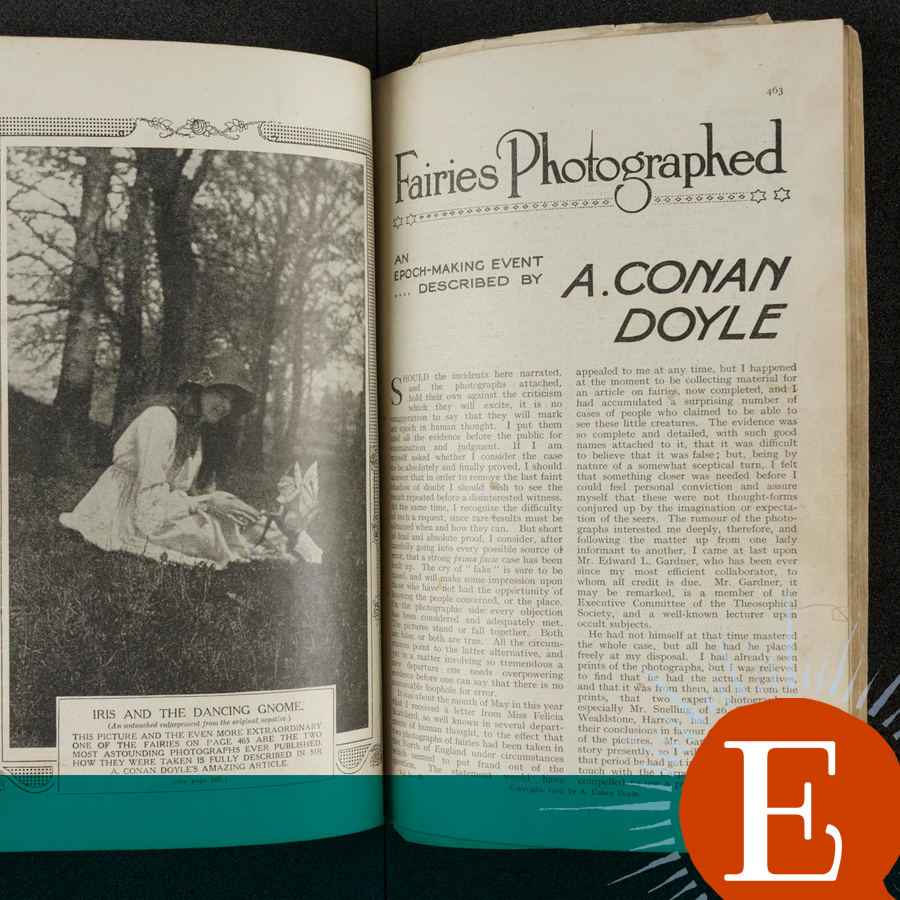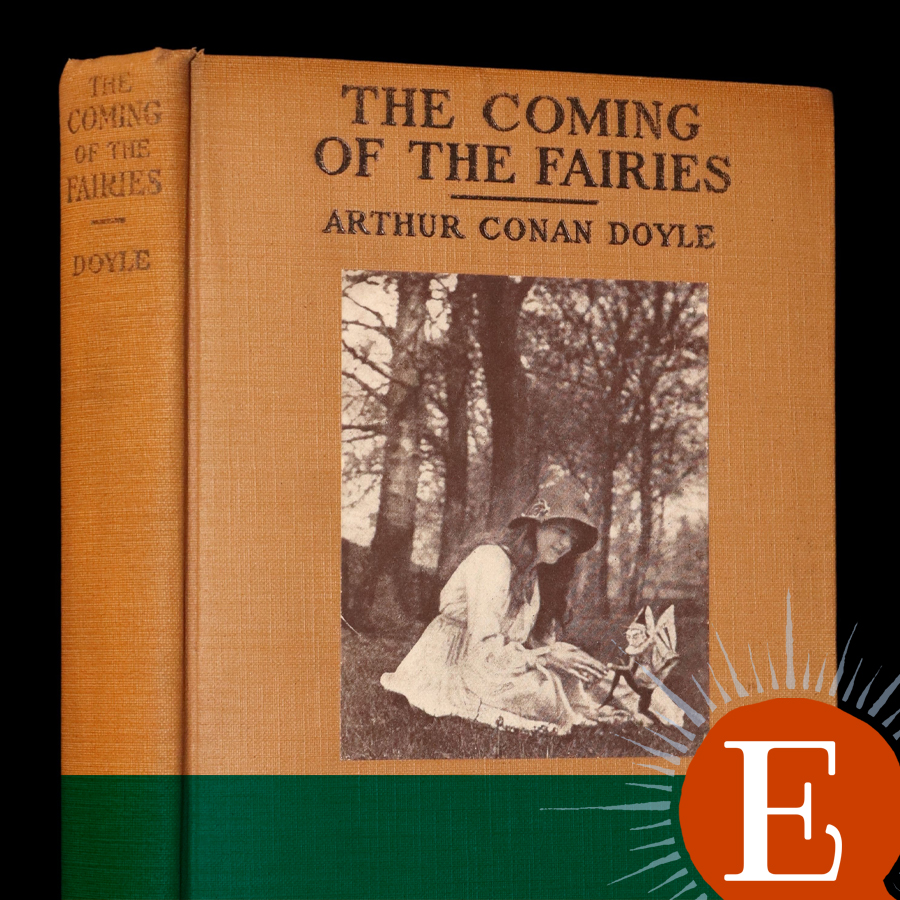
Reluctantly, Arthur Wright hands over his brand new camera to his 16-year-old daughter. It’s a Saturday afternoon in the summer of 1917 and Arthur’s daughter Elsie insists that she and her young cousin Frances simply must have the camera. Arthur entrusts them with the camera and one photographic plate—all the girls will need to take a single photograph.
Frances and Elsie traipse gleefully out of the house and towards the stream that runs behind it. It’s a beautiful setting, the sort of place children can play for hours, laughing and imagining and enjoying the natural beauty. It’s been a favorite spot for the girls for years, but today they run off with more than their usual enthusiasm. Today, they have the camera and they are going to take a picture that will bewilder their parents.
Little do they know that the picture will become the talk of the entire nation.

The girls return triumphantly in less than an hour and Elsie urges her father to develop the plate right away. Arthur takes the plate to his darkroom to develop the photograph and Elsie can’t resist slipping in to watch. As the positive image begins to show, she can’t contain her excitement. “Oh, Frances,” she calls out exuberantly, “the fairies are on the plate!”
And so they are. The photograph shows Frances, head in her hand, gazing at the camera. In front of her are four dancing winged figures. The girls have been telling their family that they have seen fairies in the woods, and now they have proof. A later photo shoot results in a picture of Elsie looking at what the girls tell the adults is a gnome.

The Wrights are perplexed and don’t know what to think of the pictures, and the photos are nearly tucked away and forgotten. But Elsie’s mother decides to bring the pictures with her to a talk in the nearby town of Bradford. It’s a decision that will change the family’s lives.
In Bradford, members of the Theosophical Society see the images and they are deeply intrigued. The Theosophical Society is a spiritualist group. They are interested in odd occurrences, unexplained phenomena, and creatures that don’t fit within a traditional biological framework. Fairies are right up their alley.

As the pictures enjoy a wider and wider circulation, they come to the attention of a very influential spiritualist of the day—Sir Arthur Conan Doyle. Doyle is well-known for his Sherlock Holmes stories and he’s well-respected, especially in the spiritualist community. And when Doyle sees the fairy pictures, he is transfixed.
He immediately sets out to confirm that the photos are genuine and to share with the world what he sees as a major historical event. Doyle publishes an article about the fairies in the popular British magazine “The Strand” then goes on to write a book. In his book The Coming of the Fairies he lays out all the evidence he has gathered. He tells of photographers who carefully examined the photographs and proclaimed them genuine.

Many in the spiritualist community are eager to accept the pictures as authentic. Some even attest that they, too, had seen fairies with their own eyes.
Doyle says of one man: “He had claimed that he had frequently seen these little people with his own eyes, and I, therefore, attached importance to his opinion.”
Many others are more skeptical. Some point out how flat the fairies look and how they appear to be shadowed differently from the rest of the photograph. Doyle has an explanation.

“To the objections of photographers that the fairy figures show quite different shadows to those of the human our answer is that ectoplasm, as the etheric protoplasm has been named, has a faint luminosity of its own, which would largely modify shadows.”
Ahh… that explains it.
One reporter visits Yorkshire to try to get to the bottom of it all. He writes, “My mission to Yorkshire was to secure evidence, if possible, which would prove or disprove the claim that fairies existed. I frankly confess that I failed.”
He does point out several interesting details of the story, like the fact that even though everyone in the little town knows about the supposed existence of the fairies, no one but the two girls ever claims to have seen them, nor have the girls invited anyone to come with them to meet the creatures. He also learns that Elsie has both a rudimentary knowledge of photography and an artistic bent.
With urging from Doyle and others, the girls produce three more photos of the fairies.



But are the fairies real? It remains an open question. Doyle ends his 1922 book with a noble sentiment.
“…for the present, while more evidence will be welcome, there is enough already available to convince any reasonable man that the matter is not one which can be readily dismissed, but that a case actually exists which up to now has not been shaken in the least degree by any of the criticism directed against it. Far from being resented, such criticism, so long as it is earnest and honest, must be most welcome to those whose only aim is the fearless search for truth.”
This “fearless search for truth” continues for nearly 60 more years, past Doyle’s death in 1930, all the way up to 1981.
For decades now, when asked if the photos are genuine and if they really saw fairies, again and again Frances and Elsie have insisted that it was all real. Frances is in her seventies when she drops a bombshell. After all this time, Frances tells the world that the photographs that led to decades of speculation and debate are nothing more than a childhood prank.
She explains that the fairies were simple cutouts held in place by hat pins. Elsie backs her up, but even as they reveal the lie behind the controversy, the women show little regret for deceiving so many for so long. They laugh at the fact that hundreds, even thousands, of people have fallen for what they see as a childish practical joke. In one interview, Frances explains her lack of remorse.
“I never even thought of it being a fraud. It was just Elsie and I having a bit of fun. I can’t understand to this day why people were taken in. They wanted to be taken in. People often say to me ‘Don’t you feel ashamed that you’ve made all these poor people look fools? They believed in you.’ But I don’t, because they wanted to believe.”
They wanted to believe.
What is it that can make someone change their beliefs?
In Genesis 3, we have a record of the first time a person changed their beliefs. Adam and Eve go from believing that they should heed God’s command not to eat the fruit of the tree to thinking that eating the fruit is actually a good idea.
Why do they change their position on the Tree of the Knowledge of Good and Evil?
Is it because the serpent presents some compelling evidence that God is untrustworthy or that His command is not valid? No, the serpent does nothing to disprove God. He simple offers an alternative position and Eve snatches it up because she likes it better. Eve changes her belief about the tree for one simple reason: she wants to.
She wants to eat the fruit and so she decides to believe that she should eat it.
When we really want to believe something, we have a way of finding evidence that supports that belief. I think that most of us are not very honest with ourselves about why we believe what we believe. We convince ourselves that we believe certain things because of cold, hard facts, and irrefutable evidence.
But it’s funny, isn’t it, how people on opposite sides of an issue can both appeal to cold, hard facts and irrefutable evidence… and still disagree with each other?
When I look at the pictures that Elsie and Frances snapped of the so-called “fairies”, I laugh at the idea that anyone could have genuinely believed the fairies were real. The fairies in the photos look flat and hand-drawn. It makes me wonder how anyone in their right mind could look at them and think they’re real. I read Arthur Conan Doyle’s book and laugh at how gullible he was.
But in a way, I’m just like him. The biggest reason Doyle believed that the fairies were real is that he wanted them to be real. The biggest reason I don’t believe the fairies were real is that I don’t want them to be real. I don’t believe in fairies.
Even now, there are those who insist that the fairy pictures Elsie and Frances took were real. Despite any evidence, despite the girls confessing that the whole thing was a farce, some people believe the girls really saw and really photographed real fairies.
How could someone continue to believe such a thing?
Because they want to believe.
For someone like me with lots of strong opinions, this is a hard pill to swallow. But we need to be honest with ourselves about why we believe what we believe. We need to be humble and ready to reexamine Scripture to determine if what we believe is really based on what God teaches.
In light of the fickleness of the human mind and emotions, I’m grateful for the work of God’s Holy Spirit. He not only helps us understand what is true from God’s Word, but He compels us to believe what is true. He not only convinces us of the truth, He makes us want to believe it.
I’m also grateful for the work of other believers. When we surround ourselves with wise Christians, they can help us avoid following our emotions into unorthodox beliefs. Ephesians 4 suggests that unity is an antidote to gullibility. Paul talks about being unified in our knowledge of Christ and growing up into maturity together so that we will not be like children…
“…tossed to and fro, and carried about with every wind of doctrine, by the sleight of men, and cunning craftiness, whereby they lie in wait to deceive;” (Ephesians 4:14)
Do you believe in fairies? If you’re not grounded, you’ll believe just about anything.
But when we live lives soaked in God’s Word, sensitive to the Holy Spirit, and in community with other believers, we guard ourselves against falling for those who lie in wait to deceive us… even if they come armed with photographic evidence.
Read The Coming of the Fairies by Arthur Conan Doyle
Read the story of the Cottingley Fairies as told by BBC and Time
Pictures of the “Midg” camera and the article in “The Strand” compliments of Science Museum Group
